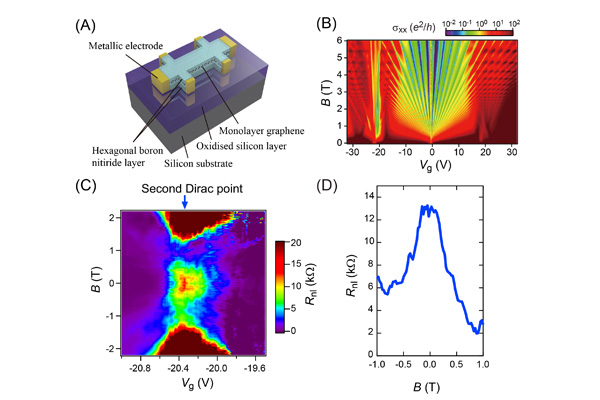- ホーム
- > 研究活動
- > Research Highlights
- > Vol. 41 Evidence of A New Type of Quan・・・
 Research Highlights
Research Highlights
[Vol. 41]
Evidence of A New Type of Quantum Effect

Figure: (A) Device structure. (B) Hofstadter’s butterfly, a quantum Hall effect in graphene/h-BN superlattice heterostructure. (C) and (D) Signature of the quantum valley Hall effect in a graphene/h-BN superlattice.
The quantum Hall effect (QHE) is a phenomenon that can occur in a two-dimensional electron gas — a system in which electrons can move in a plane but not perpendicularly to it. Such a system is typically realized in a heterostructure of thinly stacked layers of different semiconductors. The QHE is usually observed at low temperatures and high magnetic fields; it manifests itself through the quantization of values of the electronic conductance (the inverse of resistance) — the values are integer or particular fractional multiples of a fundamental conductance quantum.
Recently, variants of the QHE have been discovered, such as the quantum spin Hall and the anomalous quantum Hall effect. Now, Satoshi Moriyama at WPI-MANA, NIMS, Tsukuba, Japan, and colleagues have observed yet another relative of the QHE: the quantum valley Hall effect.
The notion of ‘valleys’ refers to electronic states having the same energy but a different crystal momentum; the states are said to lie in different valleys. A new type of electronics called ‘valleytronics’, based on the valley degree of freedom, is being researched since some years.
Moriyama and colleagues demonstrated the quantum valley Hall effect in a special heterostructure capable of hosting a two-dimensional electron gas: a sheet of graphene sandwiched between hexagonal boron nitride (h-BN) layers. Graphene is a one-atom thin layer of carbon atoms forming a honeycomb pattern. h-BN is similar; it is also a monolayer with a honeycomb structure, but it has a slightly different lattice parameter. Due to the mismatch in lattice size, the periodicity of the combined system is much larger — overlaying the two lattices results in a moiré pattern.
Importantly, the investigated electronic regime in the superlattice was ballistic: the electrons’ mean free path (the mean distance travelled between scattering events) was estimated to be 1 to 2 micrometer, which was comparable to the size of the sample.
The researchers varied the magnetic field while measuring resistances, and at a small interval centered around zero field they observed a non-vanishing resistance — a signature of the quantum valley Hall state.
An important fundamental finding on its own, Moriyama and colleagues note that it also may lead to potential applications: “[such] unconventional magnetism should have the potential for engineering the energy-band structure [of devices] even with a weak magnetic field as well as for spintronics applications.”
Reference
“Observation of the quantum valley Hall state in ballistic graphene superlattices”
Katsuyosih Komatsu, Yoshifumi Morita, Eiichiro Watanabe, Daiju Tsuya, Kenji Watanabe, Takashi Taniguchi, and Satoshi Moriyama
Journal : Sci. Adv. 4:eaaq0194 (2018).
DOI : 10.1126/sciadv.aaq0194
Katsuyosih Komatsu, Yoshifumi Morita, Eiichiro Watanabe, Daiju Tsuya, Kenji Watanabe, Takashi Taniguchi, and Satoshi Moriyama
Journal : Sci. Adv. 4:eaaq0194 (2018).
DOI : 10.1126/sciadv.aaq0194
Affiliations
International Center for Materials Nanoarchitectonics (WPI-MANA), National Institute for Materials Science (NIMS), Namiki 1-1, Tsukuba, Ibaraki 305-0044, Japan
Contact information
ナノアーキテクトニクス材料研究センター (MANA)
〒305-0044 茨城県つくば市並木1-1
TEL: 029-860-4710
E-mail: mana-pr=ml.nims.go.jp([ = ] → [ @ ] )
TEL: 029-860-4710
E-mail: mana-pr=ml.nims.go.jp([ = ] → [ @ ] )

